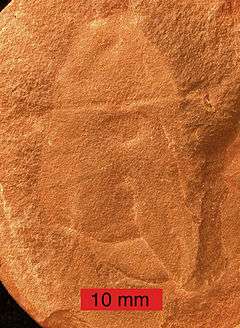Tullimonstrum
| Tullimonstrum gregarium Temporal range: Middle Pennsylvanian | |
|---|---|
| | |
| Fossil of Tullimonstrum gregarium (part and counterpart) | |
| Scientific classification | |
| Kingdom: | Animalia |
| Subkingdom: | Eumetazoa |
| (unranked): | Bilateria |
| Phylum: | incertae sedis |
| Genus: | Tullimonstrum |
| Type species | |
| T. gregarium Eugene S. Richardson, Jr., 1966 | |
Tullimonstrum gregarium, colloquially known as the Tully Monster, was a soft-bodied invertebrate that lived in shallow tropical coastal waters of muddy estuaries during the Pennsylvanian geological period, about 300 million years ago. Examples of Tullimonstrum have been found only in the Mazon Creek fossil beds of Illinois, United States.
Etymology
Tullimonstrum gregarium takes its genus name from its discoverer, Francis Tully. Appropriately, "tull" is also Norwegian for "nonsense",[1] whereas the species name, gregarium, means "common" and reflects its abundance.[2] The term 'monster' relates to the creature's outlandish appearance and strange body plan.
Description

Tullimonstrum probably reached lengths of up to 35 centimetres (14 in); the smallest individuals are about 8 cm (3.1 in) long.[1]
Tullimonstrum had a pair of fins not unlike those of a cuttlefish, and were situated at the tail end of its body. The organism also possibly featured vertical, ventral fins as well (though the fidelity of preservation of fossils of its soft body makes this difficult to determine), and typically featured a long proboscis with up to eight small sharp teeth on each "jaw", with which it may have actively probed for small creatures and edible detritus in the muddy bottom. It was part of the ecological community represented in the unusually rich group of soft-bodied organisms found among the assemblage called the Mazon Creek fossils from their site in Grundy County, Illinois.[3] The absence of hard parts in the fossil implies that the animal did not possess organs composed of bone, chitin or calcium carbonate.[1] There is evidence of serially repeated internal structures.[1] Its head is poorly differentiated.[1] A transverse bar-shaped structure, which was either dorsal or ventral, terminates in two round organs which are associated with dark material similar to the pigmentation often found in eyes. Their form and structure is suggestive of a camera-type construction.[1]
Affinity
There is insufficient evidence to align Tullimonstrum to the crown or even stem group of any phylum. Since it lacks characteristics of the well-known modern phyla, it has been speculated that it is representative of a stem group to one of the many phyla of worms that are poorly represented today.[1] Similarities with Cambrian fossil organisms have been noted. Chen, et al., suggest similarities to Vetustovermis planus;[4] and while there may be a general resemblance between Tullimonstrum and Opabinia regalis,[5] Cave, et al., point out that they are too morphologically dissimilar to be related.[6]
Ecology
Tullimonstrum was probably a free-swimming carnivore that dwelt in open marine water, and was occasionally washed to the near-shore setting in which it was preserved.[1]
Taphonomic setting

The formation of the Mazon Creek fossils is unusual. When the creatures died, they were rapidly buried in silty outwash. The bacteria that began to decompose the plant and animal remains in the mud produced carbon dioxide in the sediments around the remains. The carbon dioxide combined with iron from the groundwater around the remains, forming encrusting nodules of siderite ('ironstone'), which created a hard permanent 'cast' of the animal which slowed further decay, leaving a carbon film on the cast.
The combination of rapid burial and rapid formation of siderite resulted in excellent preservation of the many animals and plants that ended up in the mud. As a result, the Mazon Creek fossils are one of the world's major Lagerstätten, or concentrated fossil assemblages.
The proboscis is rarely preserved in its entirety; it is complete in around 3% of specimens. However some part of the organ is preserved in about 50% of cases.[1]
History
Amateur collector Francis Tully found the first of these fossils in 1958. He took the strange creature to the Field Museum of Natural History, but paleontologists remain stumped as to what phylum Tullimonstrum belongs to.
A 1966 satire pretended that modern representatives were to be found in Africa.[7][8] In 1989 Tullimonstrum gregarium was officially designated the State Fossil of Illinois.[2][9]
See also
References
- 1 2 3 4 5 6 7 8 9 Johnson, Ralph Gordon; Richardson, Eugene Stanley, Jr. (March 24, 1969). "Pennsylvanian Invertebrates of the Mazon Creek Area, Illinois: The Morphology and Affinities of Tullimonstrum". Fieldiana Geology 12 (8): 119–149. OCLC 86328.
- 1 2 Mikulic, Donald G.; Kluessendorf, Joanne (1997). "Illinois' State Fossil—Tullimonstrum gregarium" (PDF). Geobit 5. OCLC 38563956.
- ↑ Richardson, Eugene Stanley, Jr. (January 7, 1966). "Wormlike Fossil from the Pennsylvanian of Illinois". Science 151 (3706): 75–76. Bibcode:1966Sci...151...75R. doi:10.1126/science.151.3706.75-a. PMID 17842092.
- ↑ Chen, Jun-yuan; Huang, Di-ying; Bottjer, David J. (October 2005). "An Early Cambrian problematic fossil: Vetustovermis and its possible affinities". Proceedings of the Royal Society B 272 (1576): 2003–2007. doi:10.1098/rspb.2005.3159. OCLC 112007302. PMC 1559895. PMID 16191609.
- ↑ Switek, Brian (January 27, 2011). "Tully's Mystery Monster". Wired. Laelaps. Retrieved February 5, 2014.
- ↑ Cave, Laura Delle; Insom, Emilio; Simonetta, Alberto Mario (1998). "Advances, diversions, possible relapses and additional problems in understanding the early evolution of the Articulata". Italian Journal of Zoology 65 (1): 19–38. doi:10.1080/11250009809386724.
- ↑ Kloss, Gerald (June 18, 1968). "The Great Dancing Worm Hoax". The Milwaukee Journal. Retrieved March 31, 2012.
- ↑ Rory, E. Scumas (1969). The Dancing Worm of Turkana. Vanishing Press. OCLC 191964063.
- ↑ "State Symbol: Illinois State Fossil — Tully Monster (Tullimonstrum gregarium)". Illinois State Museum. Retrieved March 31, 2012.
External links
| Wikimedia Commons has media related to Tullimonstrum. |
| Wikispecies has information related to: Tullimonstrum |
- "The Tully Monster", a video by the Field Museum of Natural History
- Mazon Creek Paleobotany References by the Field Museum of Natural History